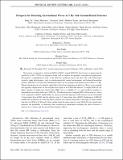| dc.contributor.author | Barr, Bryan | |
| dc.contributor.author | Hammond, Giles | |
| dc.contributor.author | Hild, Stefan | |
| dc.contributor.author | Hough, James | |
| dc.contributor.author | Huttner, Sabina | |
| dc.contributor.author | Rowan, Sheila | |
| dc.contributor.author | Sorazu, Borja | |
| dc.contributor.author | Carbone, Ludovico | |
| dc.contributor.author | Freise, Andreas | |
| dc.contributor.author | Mow-Lowry, Conor | |
| dc.contributor.author | Dooley, Katherine L. | |
| dc.contributor.author | Fulda, Paul | |
| dc.contributor.author | Grote, Hartmut | |
| dc.contributor.author | Sigg, Daniel | |
| dc.contributor.author | Yu, Hang | |
| dc.contributor.author | Martynov, Denis | |
| dc.contributor.author | Vitale, Salvatore | |
| dc.contributor.author | Evans, Matthew J | |
| dc.contributor.author | Shoemaker, David H | |
| dc.date.accessioned | 2018-04-09T18:22:38Z | |
| dc.date.available | 2018-04-09T18:22:38Z | |
| dc.date.issued | 2018-04 | |
| dc.date.submitted | 2018-02 | |
| dc.identifier.issn | 0031-9007 | |
| dc.identifier.issn | 1079-7114 | |
| dc.identifier.uri | http://hdl.handle.net/1721.1/114636 | |
| dc.description.abstract | We propose an upgrade to Advanced LIGO (aLIGO), named LIGO-LF, that focuses on improving the sensitivity in the 5–30 Hz low-frequency band, and we explore the upgrade’s astrophysical applications. We present a comprehensive study of the detector’s technical noises and show that with technologies currently under development, such as interferometrically sensed seismometers and balanced-homodyne readout, LIGO-LF can reach the fundamental limits set by quantum and thermal noises down to 5 Hz. These technologies are also directly applicable to the future generation of detectors. We go on to consider this upgrade’s implications for the astrophysical output of an aLIGO-like detector. A single LIGO-LF can detect mergers of stellar-mass black holes (BHs) out to a redshift of z≃6 and would be sensitive to intermediate-mass black holes up to 2000 M_{⊙}. The detection rate of merging BHs will increase by a factor of 18 compared to aLIGO. Additionally, for a given source the chirp mass and total mass can be constrained 2 times better than aLIGO and the effective spin 3–5 times better than aLIGO. Furthermore, LIGO-LF enables the localization of coalescing binary neutron stars with an uncertainty solid angle 10 times smaller than that of aLIGO at 30 Hz and 4 times smaller when the entire signal is used. LIGO-LF also significantly enhances the probability of detecting other astrophysical phenomena including the tidal excitation of neutron star r modes and the gravitational memory effects. | en_US |
| dc.description.sponsorship | United States. National Aeronautics and Space Administration (Grant NNX14AB40G) | en_US |
| dc.publisher | American Physical Society | en_US |
| dc.relation.isversionof | http://dx.doi.org/10.1103/PhysRevLett.120.141102 | en_US |
| dc.rights | Article is made available in accordance with the publisher's policy and may be subject to US copyright law. Please refer to the publisher's site for terms of use. | en_US |
| dc.source | American Physical Society | en_US |
| dc.title | Prospects for Detecting Gravitational Waves at 5 Hz with Ground-Based Detectors | en_US |
| dc.type | Article | en_US |
| dc.identifier.citation | Yu, Hang et al. "Prospects for Detecting Gravitational Waves at 5 Hz with Ground-Based Detectors." Physical Review Letters 120, 14 (April 2018): 141102 © 2018 American Physical Society | en_US |
| dc.contributor.department | Massachusetts Institute of Technology. Department of Physics | en_US |
| dc.contributor.department | LIGO (Observatory : Massachusetts Institute of Technology) | en_US |
| dc.contributor.department | MIT Kavli Institute for Astrophysics and Space Research | en_US |
| dc.contributor.mitauthor | Yu, Hang | |
| dc.contributor.mitauthor | Martynov, Denis | |
| dc.contributor.mitauthor | Vitale, Salvatore | |
| dc.contributor.mitauthor | Evans, Matthew J | |
| dc.contributor.mitauthor | Shoemaker, David H | |
| dc.relation.journal | Physical Review Letters | en_US |
| dc.eprint.version | Final published version | en_US |
| dc.type.uri | http://purl.org/eprint/type/JournalArticle | en_US |
| eprint.status | http://purl.org/eprint/status/PeerReviewed | en_US |
| dc.date.updated | 2018-04-06T18:00:10Z | |
| dc.language.rfc3066 | en | |
| dc.rights.holder | American Physical Society | |
| dspace.orderedauthors | Yu, Hang; Martynov, Denis; Vitale, Salvatore; Evans, Matthew; Shoemaker, David; Barr, Bryan; Hammond, Giles; Hild, Stefan; Hough, James; Huttner, Sabina; Rowan, Sheila; Sorazu, Borja; Carbone, Ludovico; Freise, Andreas; Mow-Lowry, Conor; Dooley, Katherine L.; Fulda, Paul; Grote, Hartmut; Sigg, Daniel | en_US |
| dspace.embargo.terms | N | en_US |
| dc.identifier.orcid | https://orcid.org/0000-0002-6011-6190 | |
| dc.identifier.orcid | https://orcid.org/0000-0003-2700-0767 | |
| dc.identifier.orcid | https://orcid.org/0000-0001-8459-4499 | |
| dc.identifier.orcid | https://orcid.org/0000-0002-4147-2560 | |
| mit.license | PUBLISHER_POLICY | en_US |
